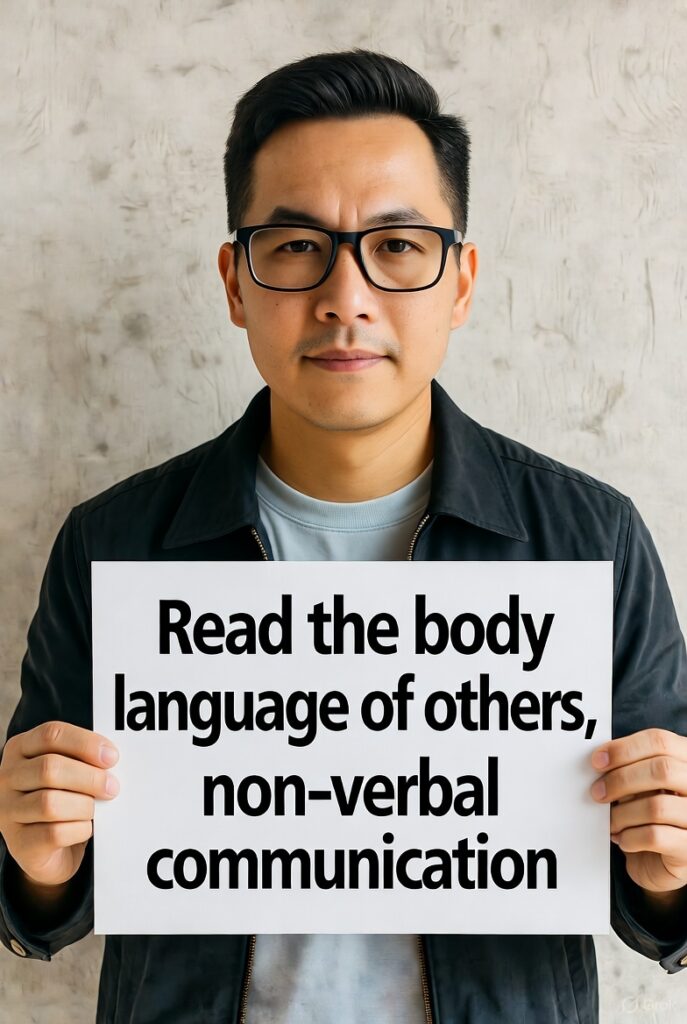
When you talk about a controversial topic, people may not always say what they really feel.
But their body language can tell you many things.
Here is how you can understand it better.
1. Posture (how someone sits or stands)
Posture shows how relaxed or defensive a person is.
- If someone sits straight and faces you, they are open and interested.
- If they lean a little forward, they want to listen or say something important.
- If they lean back, they may feel uncomfortable or want distance.
- Arms crossed can mean they are protecting themselves, disagreeing, or not ready to listen.
- Arms relaxed at the sides or hands on the table show they feel calm and safe.
- If a person turns their body away from you, they may want to stop or change the topic.
➡️ Tip: Notice if their body moves closer (interest) or away (discomfort).
2. Eyes
The eyes show emotions very clearly.
- Normal eye contact (looking at you sometimes, then away) shows they are paying attention.
- Too much eye contact (staring) can feel aggressive or angry.
- Too little eye contact (looking down or to the side) can mean they feel shy, guilty, or nervous.
- Blinking quickly can mean stress or confusion.
- Closing eyes for a moment might mean they don’t like what they heard.
- If their pupils (black part of eyes) get bigger, they are interested or emotional.
➡️ Tip: If eye contact changes suddenly, something in the topic affected them.
3. Face
Facial expressions show the person’s emotions before they speak.
- Smiling with eyes and mouth means they feel friendly or happy.
- Smiling only with the mouth means it’s a polite or fake smile.
- Tight lips, clenched jaw, or red face can mean anger or stress.
- Raised eyebrows can mean surprise, doubt, or disbelief.
- Frowning (brows down, forehead lines) shows confusion or disagreement.
- Biting lips can show worry or uncertainty.
➡️ Tip: Watch if the face becomes tighter or softer during the talk — it tells how they feel inside.
4. Hands and arms
Hands often show what a person feels, even when the face looks calm.
- Open hands mean they are honest or want to connect.
- Hiding hands, putting hands in pockets, or folding arms can mean they feel unsure or defensive.
- Pointing fingers, chopping the air, or hitting the table show strong emotion or anger.
- Playing with objects (pen, phone, hair) can mean nervousness.
- Touching face or neck can mean they feel stressed or insecure.
- Hands moving slowly and softly show calm and comfort.
➡️ Tip: When a person’s hands become very still, they might be angry or holding back feelings.
5. Voice
The voice can change with emotion even if the words are polite.
- Higher voice often means nervousness, stress, or excitement.
- Lower voice can mean calmness or trying to control emotions.
- Speaking very fast means they are emotional or want to finish quickly.
- Speaking slowly means they are thinking carefully.
- Pausing often can show they are unsure or want to choose words carefully.
- Flat tone (no emotion) can mean they are tired, angry inside, or have given up.
➡️ Tip: If the voice changes suddenly, it usually means the topic touched something important.
6. Changes during the discussion
It’s important to notice how the person changes while you talk.
- Maybe they were relaxed at the beginning but became tense later.
- Maybe they smiled before, but now look serious.
- Maybe they moved closer, but now move away.
All these are signals that their emotions are changing.
It may mean the topic became too strong, personal, or uncomfortable.
➡️ Tip: If you see this, you can pause or say something friendly like,
“Maybe this topic is a bit difficult — what do you think?”
7. Context (the situation and culture)
Not everyone uses body language the same way.
- In some cultures, eye contact is polite; in others, it can feel rude.
- Some people naturally move more, others stay still.
- Some are shy and may cross arms just because they feel cold or careful, not angry.
So, don’t judge from one sign only.
Always look for groups of signs — for example:
Crossed arms + no eye contact + short answers = possible disagreement.
➡️ Tip: Think about who the person is and what the situation is before deciding what it means.
8. How to react when you see tension
If you see that the other person is getting tense, angry, or defensive:
- Stay calm. Don’t copy their anger or tension.
- Speak slowly and softly. A quiet tone helps them relax.
- Show respect with words like:
- “I see what you mean.”
- “That’s interesting — tell me more.”
- Keep your body open:
- Don’t cross your arms.
- Sit or stand in a relaxed way.
- Nod sometimes to show you listen.
- Smile a little (if it feels natural).
- Don’t interrupt. Let them finish.
- If it’s too emotional, you can suggest to take a short break.
➡️ Tip: When you stay calm and friendly, the other person often does the same.
